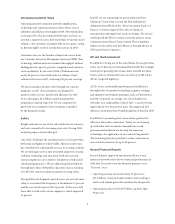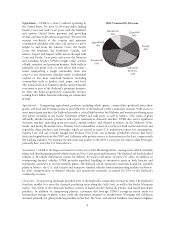Union Pacific 2006 Annual Report Download - page 10
Download and view the complete annual report
Please find page 10 of the 2006 Union Pacific annual report below. You can navigate through the pages in the report by either clicking on the pages listed below, or by using the keyword search tool below to find specific information within the annual report.
Operations – UPRR is a Class I railroad operating in
the United States. We have 32,339 route miles, linking
Pacific Coast and Gulf Coast ports with the Midwest
and eastern United States gateways and providing
several corridors to key Mexican gateways. We serve the
western two-thirds of the country and maintain
coordinated schedules with other rail carriers to move
freight to and from the Atlantic Coast, the Pacific
Coast, the Southeast, the Southwest, Canada, and
Mexico. Export and import traffic moves through Gulf
Coast and Pacific Coast ports and across the Mexican
and Canadian borders. UPRR’s freight traffic consists
of bulk, manifest, and premium business. Bulk traffic is
primarily coal, grain, rock, or soda ash in unit trains –
trains transporting a single commodity from one
source to one destination. Manifest traffic is individual
carload or less than train-load business, including
commodities such as lumber, steel, paper, and food.
The transportation of finished vehicles and intermodal
containers is part of the Railroad’s premium business.
In 2006, the Railroad generated commodity revenue
totaling $14.9 billion from the following six commodity
groups:
2006 Commodity Revenue
Agricultural
16%
Automotive
10% Chemicals
14%
Energy
20%
Industrial
Products
21%
Intermodal
19%
Agricultural – Transporting agricultural products, including whole grains, commodities produced from these
grains, and food and beverage products, provided 16% of the Railroad’s 2006 commodity revenue. With access to
most major grain markets, the Railroad provides a critical link between the Midwest and western producing areas
and export terminals in the Pacific Northwest (PNW) and Gulf ports, as well as Mexico. Unit trains of grain
efficiently shuttle between producers and export terminals or domestic markets. UPRR also serves significant
domestic markets, including grain processors, animal feeders, and ethanol producers in the Midwest, West,
South, and Rocky Mountain states. Primary food commodities consist of a variety of fresh and frozen fruits and
vegetables, dairy products, and beverages, which are moved to major U.S. population centers for consumption.
Express Lane and our recently inaugurated Produce Unit Train, our premium perishables services that move
fruits and vegetables from the PNW and California with priority service to destinations in the East, compete with
the trucking industry. We transport frozen meat and poultry to the West Coast ports for export, while beverages,
primarily beer, enter the U.S. from Mexico.
Automotive – UPRR is the largest automotive carrier west of the Mississippi River, serving seven vehicle assembly
plants and distributing imported vehicles from six West Coast ports and Houston. The Railroad off-loads finished
vehicles at 38 vehicle distribution centers for delivery by truck to all major western U.S. cities. In addition to
transporting finished vehicles, UPRR provides expedited handling of automotive parts in both boxcars and
intermodal containers to several assembly plants. The Railroad carries automotive materials bound for assembly
plants in Mexico, the U.S., and Canada and transports finished vehicles from manufacturing facilities in Mexico.
In 2006, transportation of finished vehicles and automotive materials accounted for 10% of the Railroad’s
commodity revenue.
Chemicals – Transporting chemicals provided 14% of the Railroad’s commodity revenue in 2006. The Railroad’s
franchise enables it to serve the chemical producing areas along the Gulf Coast, as well as the Rocky Mountain
region. Two-thirds of the chemicals business consists of liquid and dry chemicals, plastics, and liquid petroleum
products. In addition to transporting plastics, customers also leverage UPRR’s storage-in-transit yards for
intermediate storage of plastic resins. Soda ash shipments originate in southwestern Wyoming and California
destined primarily for glass producing markets in the East, the West, and abroad. Fertilizer movements originate
4























